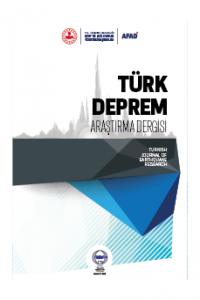Küresel Konumlama Uydu Sistemleri Tabanlı Deprem Gözlemlerinin Duyarlığı
KKUS, İvmeölçer, Yer değiştirme, RMS hata, Sinyal tutarlık analizi
Precision of Global Navigation Satellite Systems Based Earthquake Observations
GNSS, Acceleration, Displacement, RMS error, Signal coherence analysis,
___
- Aktuğ B., 2005. Uyarlamalı filtrelerle gerçek zamanlı navigasyon, HKM Jeodezi Jeoinformasyon ve Arazi Yönetimi 92, 29-37.
- Bendat J.S., Piersol A.G., 1986. Random data. Wiley-Interscience.
- Bock Y., Crowell B., Melgar D., 2011. Real time GPS/Seismic and EEW Results from El Mayor Cucapah and Tohoku-oki Earthquakes. Earthquake Early Warning Summit: Delivering Earthquake Warnings to the U.S. West Coast. Berkeley.
- Bock Y., Restrepo J., Melgar D., Offield D.G., 2012. Low-cost, strong motion sensor packages to obtain full spectrum waveforms for earthquake early warning and structural monitoring applications, NSF Final Report.
- Boore D.M., 1999. Effect of Baseline Corrections on Response Spectra for Two Recordings of the 1999 Chi Chi, Taiwan Earthquake, Restron, USGS.
- Boore D.M., 2001. Effect of baseline corrections on displacements and response spectra for several recordings of the 1999 Chi Chi, Taiwan earthquake, Bull. Seismol. Soc. Am. 91, 1199-1211.
- Boore D.M., Bommer J., 2005. Processing of strong motion accelograms: Needs, options and consequences, Soil Dynamics and Earthquake Engineering 25, 93-115.
- Boore D.M., Stephans C., Joyner B., 2002. Comments on baseline correction of digital strong-motion data: Examples from the 1999 Hector Mine, California earthquake, Bull. Seismol. Soc. Am. 92, 1543-1560.
- Brown H. M., Allen R. M., Hellweg M., Khainovski O., Neuhauser D., Souf A., 2011. Development of the elarms methodology for earthquake early warning: Realtime application in California and offline testing in Japan, Soil Dynamics and Earthquake Engineering 31, 188-200.
- Crowell B.W., Melgar D., Bock D., 2013. Earthquake magnitude scaling using seismogeodetic data, Geophysical Research Letter 40(23), 6089-6094.
- Crowell B.W., Schmidt D.A., Bodin P., Vidale J.E., Baker B., Barrientos S., Geng J., 2018a. G-FAST earthquake early warning potential for great earthquakes in Chile, Seism. Res. Lett. 89, 542-556.
- Crowell B.W., Melgar D., Geng J., 2018b. Hypothetical real-time GNSS modelling of the 2016 Mw 7.8 Kaikoura Earthquake: Perspectives from ground motion and tsunami inundation prediction, Bull. Seism. Soc. Am. 108, 1736-1745, doi: 10.1785/0120170247.
- Gelb A., 1974. Applied optimal estimation. Massachusetts, MIT Press, USA.
- Graizer V.M., 1979. Determination of the true ground displacement by using strong motion records, Earth Physics 15 (12), 875-885.
- Graizer V.M., 2006. Tilts in strong motion, Bull Seism. Soc. Am. 96(6) 2090-2102.
- Hartog J.R., Kress V.C., Malone S.D., Bodin P., Vidale J.E., Crowell B.W., 2016. Earthquake early warning: ShakeAlert in the Pacific Northwest, Bull. Seism. Soc. Am. 106, 1875-1886, doi: 10.1785/0120150261.
- Hoshiba M., Iwakiri K., 2011. Initial 30 seconds of the 2011 off the Pacific coast of Tohoku Eartthquake (Mw 9.0)-amplitude and Tc for magnitude estimation for earthquake early warning, Earth, Planet and Space 63, 553-557, 2011.
- Iwan W.D., Mooser M.A., Peng C.Y. 1985. Some observations on strong motion earthquake measuremenets using a digital accelerograph, Bull. Seism. Soc. Am. 75(5), 1225-1246. ISSN 0037-1106.
- Kedar S., Watada S., Tanimoto T. 1994. The 1989 Macquarie Ridge earthquake: Seismic moment estimation from long period free oscillations, J. Geophys. Res. 99,17893-17908.
- Liebelt P.B., 1967. An Introduction to Optimal Estimation. Massachusetts: Addison-Wesley. Merminod B., 1989. The Use of Kalman Filters in GPS Navigation, UNISRV, New South Wales, Australia.
- Murray J.R., Crowell B.W., Grapenthin R., Hodgkinson K., Langbein J.O., Melbourne T., Melgar D., Minson S.E., Schmidt D.A., 2018, Development of a geodetic component for the U. S. West Coast earthquake early warning system, Seism. Res. Lett. 89, 2322-2336, doi: 10.1784/0220180162.
- Nakamura Y., 1988. On the Urgent Earthquake Detection and Alarm System (UrEDAS), 9th world conference on earthquake engineering, Vol. VII, 673-678, 2-9 August 1988, Tokyo-Japan.
- Olson E., Allen M., 2005. The deterministic nature of earthquake rapture, Nature 438, 212-215.
- Park J., Song T., Tromp J., Okal E., Stein S., Roult G., Clevede E., Laske G., Kanamori H., Davis P., Berger J., Braitenberg C., Van Camp M., Lei X., Sun H., Xu H., Rosat S., 2005. Earthquakes frss oscillations excited by the 26 December 2004 Sumatra-Andaman earthquake, Science 308, 1139-1144, 20 May 2005.
- Penny W.D., 2000. Signal Processing Course, Institute of Neurology, University College London, UK.
- Pillet R., Virieux J. 2007. The effects of seismic rotations on inertial sensors, Geophysical Journal International 171(3), 1314-1323, doi: 10.1111/j.1365-246X.2007.03617.x
- Ruhl C.J., Melgar D., Geng J., Goldberg D.E., Crowell B.W., Allen R.M., Bock Y., Barrientos S., Riquelme S., Baez J.C., Cabral-Cano E., Perez-Campos X., Hill E.M., Protti M., Ganas A., Ruiz M., Mothes P., Jarrin P., Nocquet J.M., Avouac J.P., D'Anastassio E., 2019. A global database of strong motion displacement GNSS recordings and an example application to PGD scaling, Seism. Res. Lett. 90(1), 271-279, doi: 10.1785/0220180177.
- Schwarz K.P., Krynski J., 1989. Fundamentals of Geodesy, University of Calgary, Department of Surveying Engineering, 177p.
- Strang G., Borre K., 1997. Linear algebra, geodesy, and GPS, Wellesley Press, ISBN 978-0961408862, Cambridge, 624p.
- Wu Y., Kanamori H., 2005. Experiment on Onsite Early Warning Method for the Taiwan Early Warning System, Bull. Seismol. Soc. Am. 95(1), 347-353, doi: 10.1785/0120040097
- Wu Y.M., Zhao L., 2006. Magnitude estimation using the first three seconds P-wave amplitude in earthquake early warning, Geophys. Res. Lett. 33, L16312. doi:10.1029/2006GL026871
- Başlangıç: 2019
- Yayıncı: Afet ve Acil Durum Yönetimi Başkanlığı (AFAD)
Gerçek Zamanda Bir Deprem Olayında Binaların Kullanılabilirlik Kararı İçin Sürekli Ötelenme Ölçümü
2019 Türkiye Bina Deprem Yönetmeliğinde Başlıca Yenilikler
Manisa ve Çevresinde Deprem ve Patlatma Verilerinin Ayırt Edilmesi
Nalan CEYDİLEK, Gündüz HORASAN
Ayşegül ASKAN GÜNDOĞAN, Shaghayegh KARİMZADEH
Kuzey Anadolu Fay Zonu’nun (KAFZ) Orta Kesimi İçin Yeni Bir Kuvvetli Yer Hareketi Azalım İlişkisi
Nilgün Lütfiye SAYIL, Aleyna GENÇOĞLU
Küresel Konumlama Uydu Sistemleri Tabanlı Deprem Gözlemlerinin Duyarlığı
